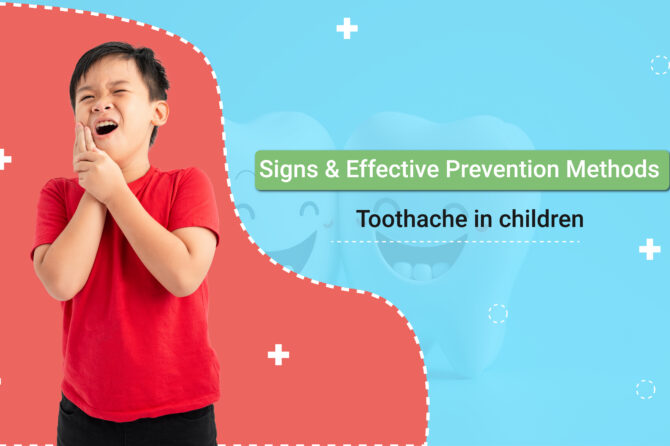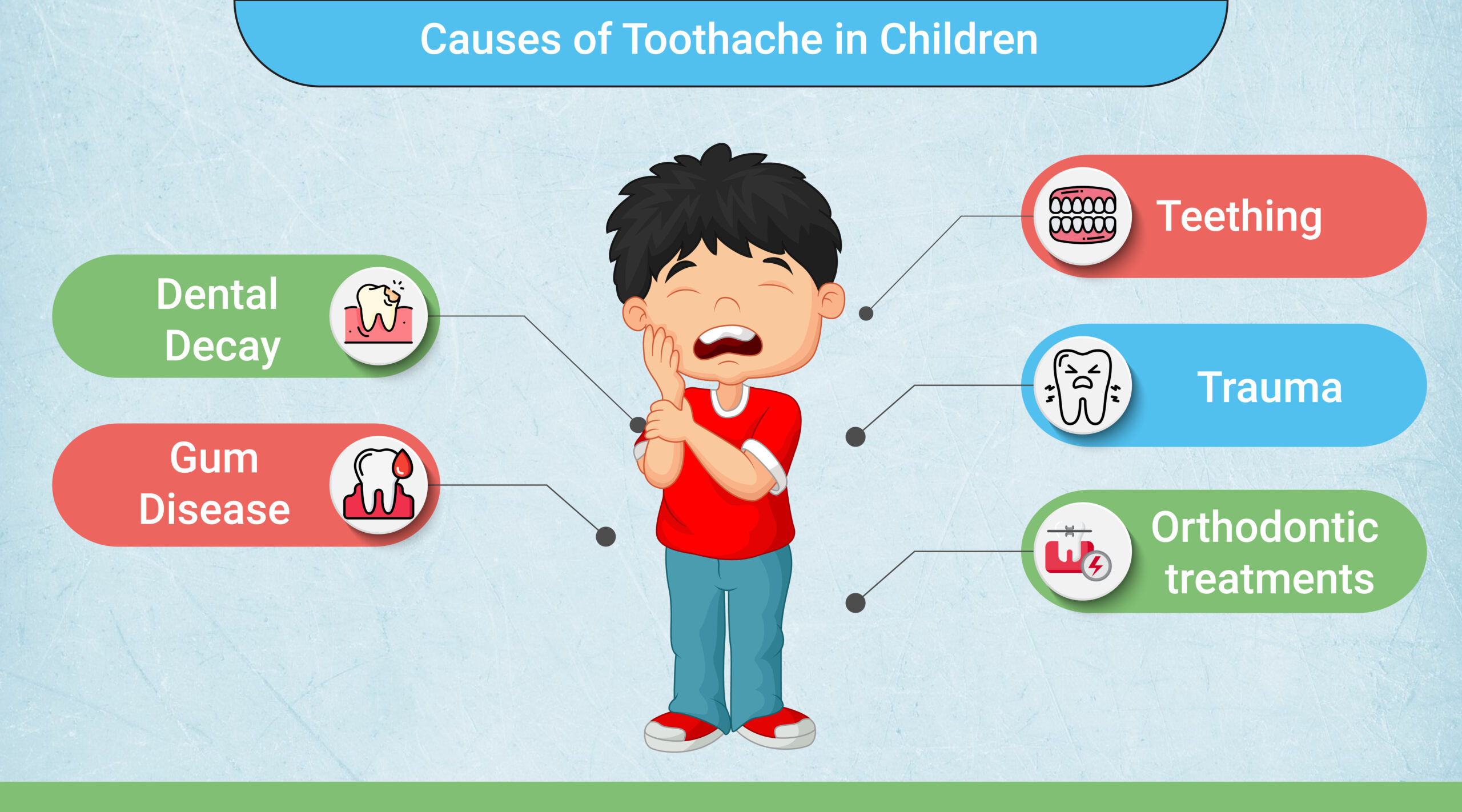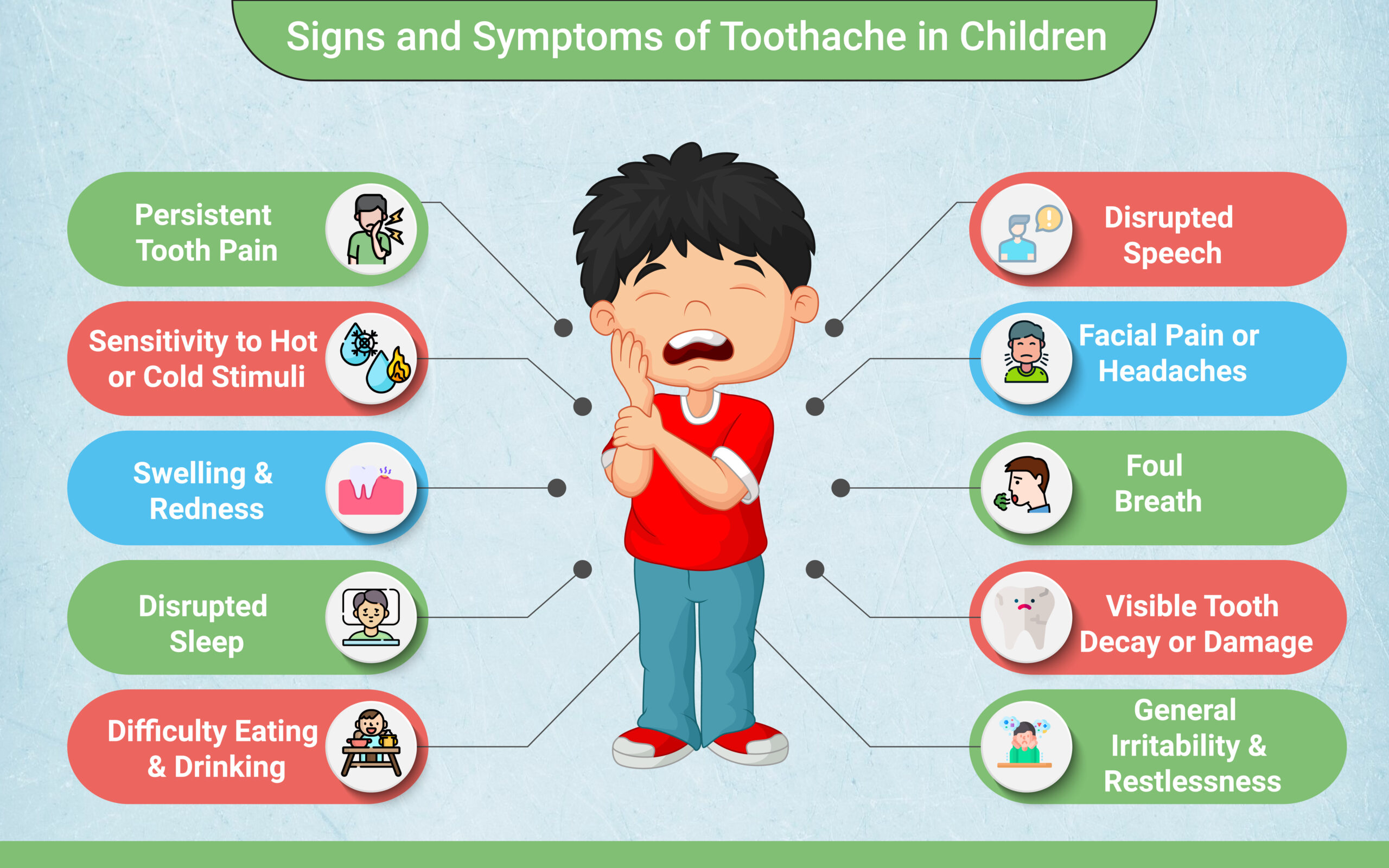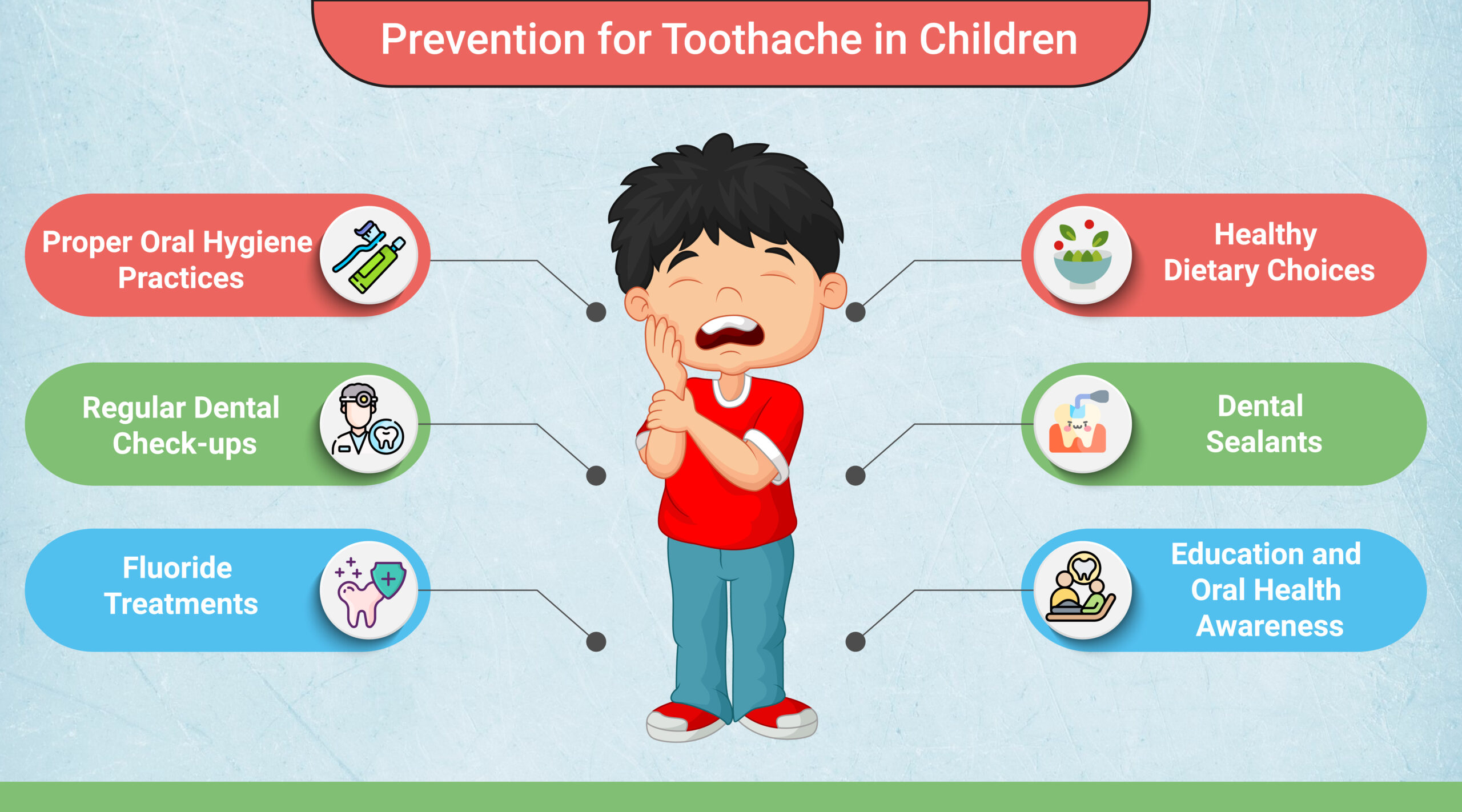
Uncover the Signs and Effective Prevention Methods for Toothache in Children
Toothache in children is a distressing ailment that arises from a variety of causes intricately intertwined with their delicate oral health. The torment of tooth pain, relentless in its grip, stems from several factors that assail the vulnerable structures within their tender mouths. Exploring the enigmatic nature of this affliction, we shall unravel the complex tapestry woven by the culprits of toothache in children, all while endeavoring to discover effective treatments that can alleviate their suffering.
What are the causes of toothache in children?

- A primary culprit behind toothache in children is dental decay, a treacherous force that erodes tooth enamel and infiltrates the inner recesses of the teeth. Bacteria feast upon carbohydrates, releasing acids that corrode the protective layers of the teeth. This microbial onslaught results in the formation of cavities, which expose the delicate nerve endings within, triggering the intense tooth pain experienced by children.
- Gum disease emerges as another prominent cause, silently undermining the stability of the teeth. Inflammation and infection wreak havoc on the gum tissues, eroding their foundation and giving rise to pulsating discomfort. As gum disease progresses, it weakens the teeth’s support system, leaving them susceptible to the onslaught of toothache.
- Teething, a natural milestone in dental development, paradoxically contributes to toothache in children. As new teeth emerge through the tender gums, it can induce localized inflammation and discomfort, causing temporary tooth pain as the teeth break through the gum tissue.
- Trauma, an unforeseen force, can abruptly thrust children into the throes of toothache. Accidents, falls, and sports-related injuries can inflict damage upon the delicate structures of the teeth. Fractures, dislocations, or tooth loss expose the sensitive nerve endings, subjecting children to intense tooth pain.
- Orthodontic treatments, designed to align misaligned teeth, can also trigger toothache in children. Braces or aligners apply mechanical forces to the dentition, which can cause discomfort and tooth pain, particularly during the initial stages of treatment as the teeth adjust to their new positions.
To alleviate toothache in children, a multi-faceted approach is necessary. Emphasizing preventive measures, such as maintaining good oral hygiene practices, protecting against dental tooth decay, and fortifying defenses against gum disease, can significantly reduce the incidence of toothache. Swift intervention and seeking professional dental care are crucial in addressing dental trauma and managing the challenges posed by orthodontic treatments.
Signs and Symptoms of Toothache in Children:

- Persistent Tooth Pain: The relentless agony experienced by children afflicted with toothache is a manifestation of the excitation of dental nerve endings, triggered by various underlying causes. This pain can be sharp, throbbing, or constant, as if the very essence of torment has found its dwelling within the confines of their delicate teeth.
- Sensitivity to Hot or Cold Stimuli: The hypersensitivity of the affected tooth to temperature fluctuations acts as a cruel reminder of the intricate neural network embedded within. The firing of nociceptive nerve fibers in response to thermal stimuli intensifies the perception of toothache, leaving the child yearning for relief from this fiery torment.
- Swelling and Redness: Inflammatory processes, ignited by the underlying causes of toothache, lead to the accumulation of immune cells and vascular dilation. The resulting swelling and redness in the surrounding tissues serve as stark indicators of the battle waged beneath the surface, as the body’s defenses struggle to combat the distressing intruders.
- Disrupted Sleep: The relentless tooth pain that plagues the child’s nights, akin to a malevolent presence lurking in the shadows, disturbs their slumber. Rest becomes an elusive concept as the throbbing ache intensifies in the silence of the night, stealing away the solace that sleep should bring.
- Difficulty Eating or Drinking: Toothache’s tenacious grip extends its reach to the simple pleasures of nourishment, rendering the act of eating or drinking a torturous ordeal. The pressure exerted on the affected tooth during mastication or the contact with food or beverages of varying temperatures exacerbates the existing pain, robbing the child of sustenance and enjoyment.
- Disrupted Speech: The child’s innocent attempts to communicate are hindered by toothache’s malevolent influence. The pain reverberates through the nerves, inhibiting their ability to articulate words with ease, leaving their speech distorted and strained.
- Facial Pain or Headaches: The intricate interconnections of nerves and sensory pathways draw facial pain and headaches into the sphere of toothache. The radiating discomfort stemming from the afflicted tooth can extend to the surrounding facial structures, triggering headaches that further torment the child’s already burdened existence.
- Foul Breath: The pernicious agents underlying toothache can unleash a cascade of detrimental effects, including the release of volatile sulfur compounds. These compounds give rise to a foul odor, perpetuating a cycle of discomfort and embarrassment for the child, who becomes acutely aware of their tainted breath.
- Visible Tooth Decay or Damage: Dental decay or trauma that causes toothache may manifest as visible signs of deterioration or damage to the affected tooth. This can include the presence of cavities, fractures, discoloration, or irregularities in tooth structure, serving as tangible evidence of the tooth’s struggle against the relentless assault of pain.
- General Irritability and Restlessness: Toothache, an unwelcome companion that infiltrates every aspect of a child’s life, brings with it a pervasive sense of irritability and restlessness. The ceaseless discomfort disrupts their equilibrium, casting a shadow upon their once carefree existence and leaving them yearning for the respite that a cure for toothache can bring.
In the bleak world of tooth pain in children, these signs and symptoms form a tapestry of suffering, woven with the scientific intricacies of dental pathology. It is a battle fought on the frontlines of pain, where the child’s innocence and well-being hang in the balance. But let us not despair, for within the realm of modern dentistry lies the promise of relief. With targeted treatments and compassionate care, we can endeavor to quell the torment of toothache and restore the child’s radiant smile.
Preventive Measures for Toothache in Children:

- Proper Oral Hygiene Practices: The diligent and consistent practice of proper oral hygiene, including brushing and flossing, stands as the cornerstone of preventing toothache in children. By removing plaque, a biofilm harboring bacteria and their acidic byproducts, from tooth surfaces, the risk of dental decay and subsequent tooth pain is significantly reduced. This ritual serves as a sentinel, warding off the forces that seek to inflict oral torment upon the young.
- Regular Dental Check-ups: Scheduled visits to a dental professional for routine check-ups play a pivotal role in preventing toothache in children. These appointments provide an opportunity for early detection and intervention, allowing for the identification and treatment of dental issues before they escalate into painful afflictions. The expert eye of the dentist becomes a beacon of hope, guiding us towards the path of oral health and liberation from tooth pain.
- Fluoride Treatments: The application of fluoride, a mineral renowned for its protective properties, can fortify the teeth against dental decay and subsequent toothache. Fluoride treatments, administered by dental professionals, strengthen tooth enamel, making it more resistant to the acidic assault of bacteria. This shield, forged in the crucible of scientific research, becomes a potent guardian, fending off the ravages of dental agony.
- Healthy Dietary Choices: Nourishing the young with a wholesome and balanced diet assumes paramount importance in preventing toothache. Limiting the consumption of sugary and acidic foods and beverages reduces the availability of fermentable carbohydrates, depriving the bacterial invaders of their sustenance. This dietary vigilance becomes a bulwark against tooth decay and the anguish it brings.
- Dental Sealants: The application of dental sealants, a thin protective coating, can effectively shield the vulnerable pits and fissures of the teeth from the incursion of bacteria. This barrier, created through the meticulous application of scientific ingenuity, prevents the onset of dental decay and the ensuing toothache, ensuring the child’s tranquility.
- Education and Oral Health Awareness: Empowering children with knowledge about oral health and the importance of preventive measures can foster a sense of responsibility and empowerment. By instilling good oral hygiene habits and raising awareness about the causes and consequences of toothache, we equip them with the tools to protect themselves from the clutches of dental torment.
Each of these preventive measures stands as a sentinel, an emissary of hope, guarding against the malevolent forces that conspire to inflict toothache upon the innocent. With scientific precision and unwavering determination, we erect a fortress of prevention, repelling the assaults of dental decay and safeguarding the child’s oral well-being. In the realm of oral health, the pursuit of prevention emerges as a resolute act of defiance, a testament to our commitment to spare the young from the agony of tooth pain.
Conclusion
In the world of pediatric dental discomfort, where the specter of toothache looms large, understanding the symptoms becomes paramount. From the unrelenting tooth pain and heightened sensitivity to hot or cold stimuli, to the unwelcome swelling, disrupted sleep, and challenges in eating or speaking, these telltale signs reveal the distress that afflicts our young ones. However, hope resides in the realm of prevention. By embracing proper oral hygiene practices, regular dental check-ups, fluoride treatments, healthy dietary choices, dental sealants, and comprehensive oral health education, we can erect a shield against the causes of toothache in children. At Kids Dental Studio, we pledge our unwavering commitment to the dental well-being of children, offering effective toothache treatments and compassionate care. Trust us to deliver the cure for toothache, ensuring their smiles shine brightly, untouched by the anguish of dental pain.
Leave a reply
Leave a reply